REVEALED
Only for Gray-Haired Ladies?
I’m coming out. Today. Let me explain.
Decades ago, when just starting getting my hands in the dirt, I — perhaps other people, perhaps it was even true — thought it was only gray-haired ladies who grew African violets. As it turns out, a number of years after I had started gardening, I was offered an African violet plant (by a gray-haired lady). Back then, before I had accumulated too many plants, I was less discriminating than I am these days. I accepted.
I figured I could provide the special conditions African violets demand, according to what I read in numerous publications. “Proper watering and soil moisture is critical to your success,” I was told by one publication. I could provide the needed consistently moist soil with a potting mix especially rich in peat, compost, or some other organic material. I could monitor the plants thirst by lifting the pot to feel its weight or by periodic probing its soil with my electronic moisture meter. 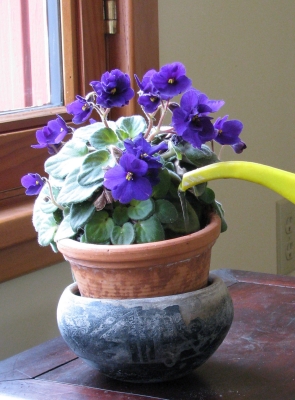 I could of course be careful to avoid leaf spotting by not spilling any water, especially cold water, on the leaves. Watering from below would do the trick, with periodic leaching from above to prevent buildup of salts. They also like high humidity.
I could of course be careful to avoid leaf spotting by not spilling any water, especially cold water, on the leaves. Watering from below would do the trick, with periodic leaching from above to prevent buildup of salts. They also like high humidity.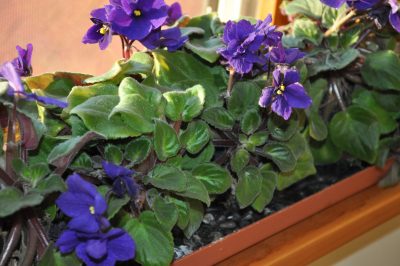
Other requirements of African violets that were and are stated are temperatures 70-90 degrees (F) by day and 65-70 degrees at night. I was also admonished to keep an eye out for pests, including aphids, cyclamen mites, and mealybugs, and symptoms of disease. Root rot, for example.
Oh, and regular feeding should be administered except when resting (to the plants, not me).
I Didn’t Follow Directions
Whew! Sounds like a rest would be needed (for me, not the plant).
Anyway, I did take up the challenge and grew and still grow African violets. And over a few years, despite not being gray-haired (at the time) and not being a lady, I’ve grown to really like the plant. Which, today, I publicly admit.
I also admit to not following most “Rules for growing African violets.” For starters, I use the same home made potting mix of equal parts peat, compost, perlite, and garden soil, with some soybean meal, that I use with most all of my other plants.
I don’t pay close attention to watering; the lightweight pot of soil and plant often tells me that the soil has gone bone dry. I do water from below, usually. But I never deliberately flood the pot with water from above to leach out any salts that may have accumulated.
The only feeding the plants get is from what microbial action provides as the microbes metabolize the compost and soybean meal on the potting mix.
As to temperature, the plants in my bedroom experience low temperatures into the fifties in winter. That indoor winter air is drier than these humidity-loving plants care for. In summer, the window is open on their sill so temperatures are pretty much the same as outdoors.
Winter Beauty . . . and Fun
Midwinter is when I admire and appreciate the plant. Despite my lackadaisical care, two plants, propagated and re-propagated again and again from the original plant, reliably display their purple blossoms for weeks. What a welcome contrast they are to the scene outside their window, the subdued browns and grays or, depending the weather, the landscape washed over in white.

I also like my African violets because they’re fun to propagate. My plants demand this every year or two when their crown, which is nothing more than plant whose stem and side branches have been telescoped down leaving only a fraction of an inch from one leaf to the next along the stem. Eventually, side branches overcrowd each other and the crown.
One way to afford a plant more elbow room is to move it to a larger pot. Another way is it just cut it into sections, each having some leaves and some root, and repot each section.
But the fun way to propagate new plants is with leaf cuttings. I take a leaf, or leaves, and stick each leaf stalk in some potting mix.
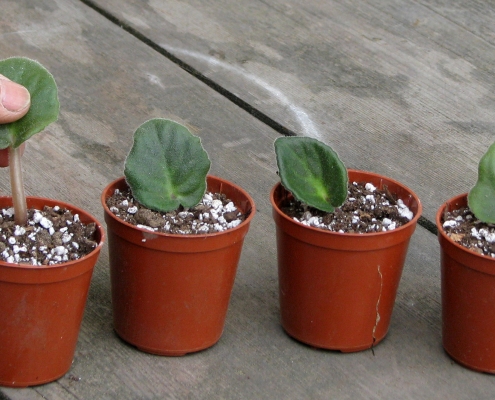
I cobble together a mini-greenhouse of plastic or glass to keep the air above these rootless leaf cuttings moist. These rooting leaves need light so that they can make food for root growth and the developing plantlets. 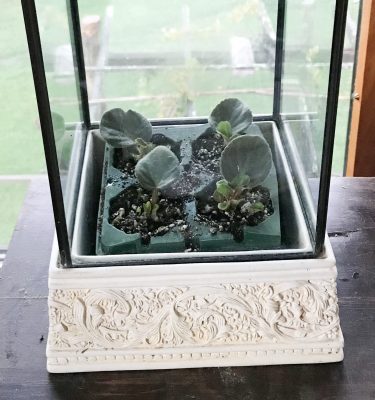 Direct sunlight on a mini-greenhouse would cook the plants within, so I keep it in bright, but indirect, light. Once plantlets appear, I begin to vent the mini-greenhouse, eventually removing the covering and moving the growing plants to their own or larger pots.
Direct sunlight on a mini-greenhouse would cook the plants within, so I keep it in bright, but indirect, light. Once plantlets appear, I begin to vent the mini-greenhouse, eventually removing the covering and moving the growing plants to their own or larger pots.
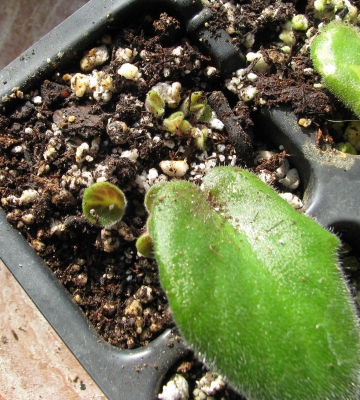
African violet leaves, rooting

Plants ready to move
Leaf cuttings give me lots of new, young plants. Despite my affection for the mother plants, I walk her over to the compost pile. No, I’m not being ruthless; she lives on in the new plants, which are clones of her, genetically exact replicas. I save two or three of them and — with minimal care on my part — in time they go on to cheer up the winter scene from indoors.


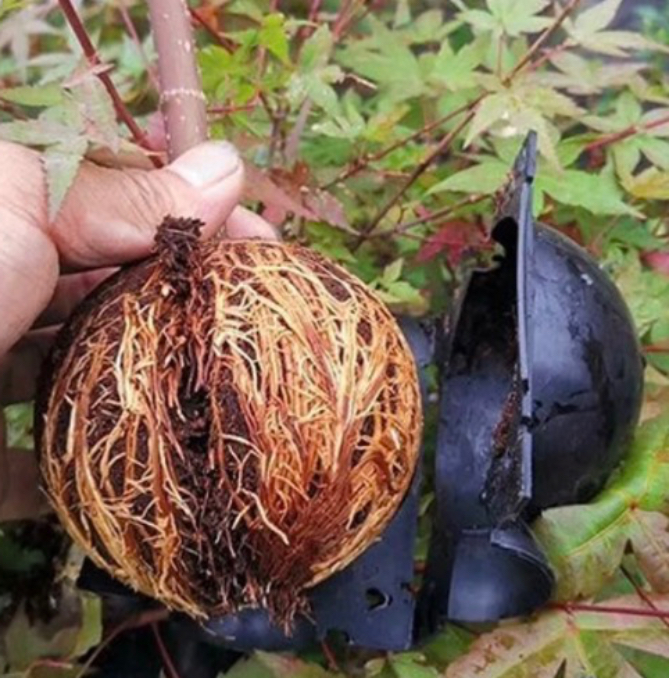
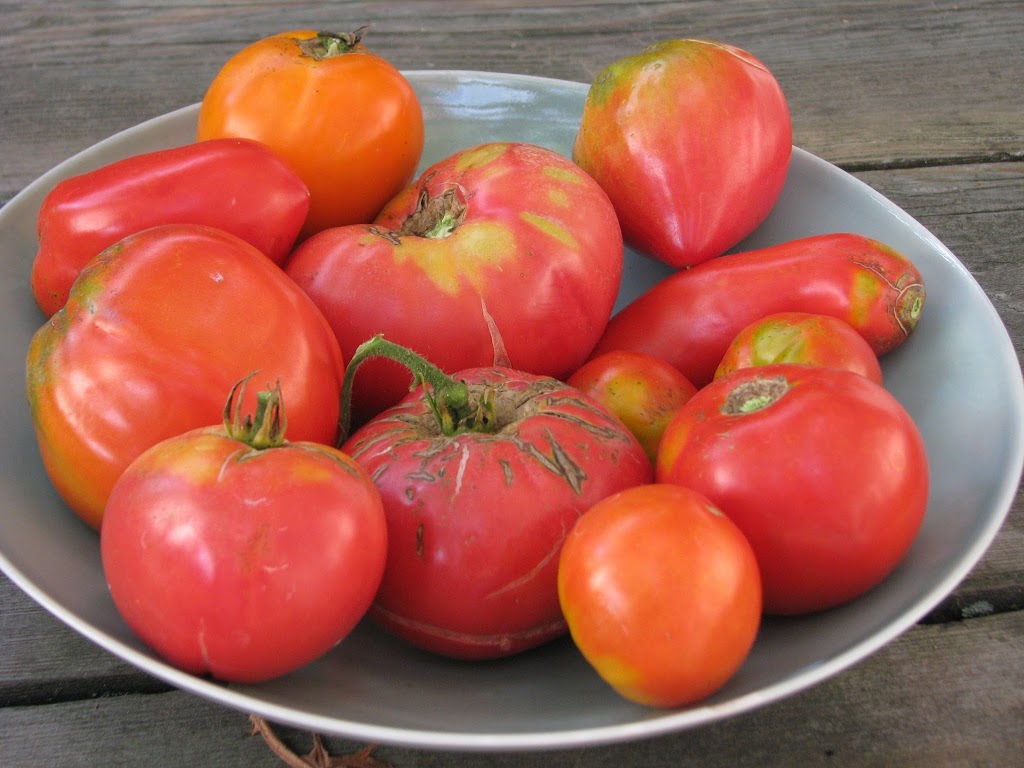
Leave a Reply
Want to join the discussion?Feel free to contribute!